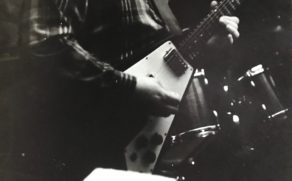So many human situations call for improvisation in some form. If you’re cooking and you don’t have quite all the right ingredients, you have to improvise (or make an annoying, unscheduled trip to the market!).
When you go out on a date with someone for the first time, you have no choice but to improvise what to talk about. You don’t really know where the conversation will go, but you must say whatever you can to move it along, as you desperately try not to feel or sound like an idiot!
I am now improvising as I type. I had no inspiration on what to write today. With nothing to go on, I typed out the word “Improvisation” at the top of the page. I stared at that really big word and said to myself, “Okay, pretend it’s your turn to ‘take a solo.’ On the count of four beats start riff writing whatever drivel that comes to mind.”
There is no denying that the art of improvisation is with us on a daily basis in a multitude of everyday-life activities. So why is improvisation so scary for some when called for in a given musical moment? Improvisation in music is spontaneous creativity that is owned and operated solely by its spontaneous creator.
Having said that, here’s Rudy Tanzi, discussing how improvisation can even be transcendent!
https://www.pbs.org/wgbh/nova/video/rudy-tanzi-a-scientist-gets-transcendent/
Therefore, in true improv, there are no wrong notes…at worst, maybe a few bad choices. Let me qualify that statement by mentioning that certain parameters must be in place. These might be in the form of a scale that works well in the specific key that you are playing in. You might adhere to this scale, or add “experimental” notes to it. These trial notes are from one moment in time. They are not pre-ordained, nor submitted for approval to the esteemed “Supreme Board of Improvisation for the Sanctity of Good Taste in Note Choice.”
That’s not to say that a particular improvised solo might not exactly be the greatest piece of work the individual musician has ever done. As a matter of fact, that person who created that spontaneous solo might think it’s about the worst thing they’ve ever played up to that point in their life! Yet that’s no reason to melt into the background and shake your head in the negative the next time the bandleader looks at you and says, “Take it!”
The “Classical” Excuse
There are many classical musicians who will tell you that they are strictly readers and have no interest in attempting to improvise. This is all well and good and perhaps, I should just let it go at that…but as usual, I can’t. Almost all professional classical musicians that have been through Conservatory have had to play in multiple recitals as part of their training. This would no doubt include playing a concerto for their particular instrument, which almost always includes a cadenza. This is an unaccompanied, (get ready for it!) improvised solo that occurs usually near the end of the piece. I don’t mean to split hairs, but when classical musicians say they never improvise nor ever care to, they aren’t really being truthful. Also, J.S. Bach was a great improviser, and no doubt many of his works were born out of this activity. C’mon folks! If it was good enough for the Bach man…why not give a go?
Okay, I’ll leave my classical friends alone from here on out. Other than the “classical excuse,” I tend to believe that the improv-challenged musicians fall into two other categories:
1) Those who are content to play the straight melody to a song as their solo, with little or no embellishment to that melody. At least these people have the wherewithal to take a solo when given the chance. This group of players can be coached to vary the rhythmic elements of the melody, thus getting away from the rigid sheet music transcription. Another teachable technique is how to fill in the gaps created by half notes and whole notes with an added-extra note or two.
2) Those who memorize a solo from one of their favorite instrumentalists – It might be something flashy and technically amazing. It is of course a very worthwhile use of one’s time to learn these solos from your favorite artists. The downside is that you have to make sure that the group that you’re jamming with is playing the actual song from which you prepared and memorized this amazing solo…or at the very least, has the same chord progression as the song your planned-out solo came from. This strategy is kind of limiting in this way. Of course there is an obvious upside to this scenario as well. You will definitely know what song to play when they ask you!
If I were you, and at this point in your ability level where you can learn difficult solos, this would certainly be a good time to try your own take on improvising! If there is still improv hesitancy, I have two words…You Tube!
Improvising for the first time…Worth the Risk!
Trying to play a solo for the first time (or second, or third…) will most definitely take you out of your comfort zone. That’s okay. Soloing is no where near as scary as say…bungee jumping. I myself have not tried that, nor I doubt if I ever would. It’s certainly safe to say that whether surviving a bungee jump or your first improvised solo, the elation you feel will indeed be transcendent!
Coming up, is a video that shows you how to play a basic A minor pentatonic scale and, how to use it to solo with a Spanish-style chord progression. The vehicle used to help make this presentation is a page out of Jeff Belding’s Guitar Tab Sketchbook. Read more about this book here and you can buy it on Amazon here.
The video will present some approaches on how to play your guitar along with this chord progression (or for that matter, any instrument that you can play this five-note scale on). Here is the chord progression and scale:
Give it a shot and play along. It’s bags of fun!
Finally, one of my previous posts called What should I practice today? includes a free download of the A minor pentatonic scale. This tab gives you some variations on how you can approach this scale – the download for the guitar is available in my store here. There are also free scales for mandolin/fiddle and banjo.
We’ll continue to dive even further into the art of Improvisation as time goes on. This presentation will help to get your feet wet and to overcome any remaining “Improv Anxiety.” Maybe if you’re willing to try improvising, I will try bungee jumping…NOT!!!



